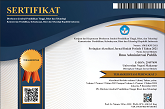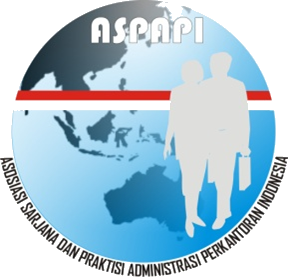Strategy of the Regional Disaster Management Agency in Tackling Disasters in Sukabumi City
(1) Muhammadiyah Sukabumi University, Sukabumi, Indonesia
(2) Muhammadiyah Sukabumi University, Sukabumi, Indonesia
(3) Muhammadiyah Sukabumi University, Sukabumi, Indonesia
(*) Corresponding Author
DOI: https://doi.org/10.26858/jiap.v13i1.43277
Abstract
Sukabumi City Regional Disaster Management Agency as an autonomous unit that was previously based on field level, which was followed up by Sukabumi Mayor Regulation No. 77 of 2020 concerning the Main Duties and Functions of BPBD located in Sukabumi City. Regional disasters that occurred in Sukabumi City were dominated by floods and landslides, in 2022 in January-March there were 54 hydrometeorologically controlled disasters. Types of disasters consist of floods, tornadoes, extreme weather, fires, and landslides. The results of the data are based on information derived from the Disaster Data Electronic Information System or called Si Edan. This research uses (Mintzberg et al., 2003) including goals/objectives, policies, and stages/programs. Qualitative research methods with a phenomenological approach, data collection techniques, namely observation, interviews and documentation. Data validation using triangulation techniques. Data analysis used includes 1). Data reduction; 2). Presentation of data; 3). Drawing conclusions. The Sukabumi City Regional Disaster Management Agency uses the concept of penta helix or multi-party where there are various elements that help in disaster management, The strategic policy of the Regional Disaster Management Agency is always seen from the index of areas that experience disaster-prone potential. Supporting factors in the stages of activities / programs are the many parties and volunteer communities that are ready to participate in disaster management activities.
Keywords
Full Text:
PDFReferences
Amagai, T., Ichimaru, S., Tai, M., Ejiri, Y., & Muto, A. (2014). Nutrition in the Great East Japan Earthquake Disaster. Nutrition in Clinical Practice, 29(5), 585–594. https://doi.org/10.1177/0884533614543833
Astarita, V., Giofrè, V. P., Guido, G., Stefano, G., & Vitale, A. (2020). Mobile Computing for Disaster Emergency Management: Empirical Requirements Analysis for a Cooperative Crowdsourced System for Emergency Management Operation. In Smart Cities (Vol. 3, Issue 1, pp. 31–47). MDPI AG. https://doi.org/10.3390/smartcities3010003
Bragg, C., Gibson, G., King, H., Lefler, A. A., & Ntoubandi, F. (2018). Remittances as aid following major sudden-onset natural disasters. Disasters, 42(1), 3–18. https://doi.org/10.1111/disa.12229
Creswell, J. W. (1999). Mixed-method research: Introduction and application. In Handbook of educational policy (pp. 455–472). Elsevier.
Creswell, J. W. (2010). Mapping the developing landscape of mixed methods research. SAGE Handbook of Mixed Methods in Social & Behavioral Research, 2, 45–68.
Creswell, J. W. (2013). Research Design: Qualitative Approach, Quantitative and Mixed. Yogyakarta: Student Library.
Creswell, J. W., & Clark, V. L. P. (2017). Designing and conducting mixed methods research. Sage publications.
Creswell, J. W., & Creswell, J. D. (2017). Research design: Qualitative, quantitative, and mixed methods approaches. Sage publications.
Creswell, J. W., & Poth, C. N. (2018). Qualitative inquiry Research Design Choosing Among Five Approaches (Vol. 53, Issue 9). SAGE Publications Ltd. https://doi.org/10.1017/CBO9781107415324.004
Elvas, L. B., Mataloto, B. M., Martins, A. L., & Ferreira, J. C. (2021). Disaster Management in Smart Cities. In Smart Cities (Vol. 4, Issue 2, pp. 819–839). MDPI AG. https://doi.org/10.3390/smartcities4020042
Ha, K.-M. (2020). Rank-Oriented Disaster Management: The Korean Experience. International Journal of Public Administration, 43(10), 839–849. https://doi.org/10.1080/01900692.2019.1660988
Hamid, M., Maheen, S., Cheem, A., & Yaseen, R. (2017). Impact of Human Resource Management on Organizational Performance. Journal of Accounting & Marketing. https://doi.org/10.4172/2168-9601.1000213
Ivkov, M., Blešić, I., Janićević, S., Kovačić, S., Miljković, D., Lukić, T., & Sakulski, D. (2019). Natural Disasters vs Hotel Industry Resilience: An Exploratory Study among Hotel Managers from Europe. Open Geosciences, 11(1), 378–390. https://doi.org/10.1515/geo-2019-0030
John W Creswell. (2013). Research Design Pendekatan Kualitatif, Kuantitatif, dan Mixed (Tiga). Pustaka Pelajar.
Miles, M. B., Huberman, A. M., & Saldana, J. (2014). Qualitative Data Analysis: A Methods Sourcebook (3rd ed.). Sage Publications.
Mintzberg, H., Ghoshal, S., Lampel, J., & Quinn, J. B. (2003). The strategy process: concepts, contexts, cases. Pearson education.
Nyberg, A. J., Moliterno, T. P., Hale, D., & Lepak, D. P. (2014). Resource-Based Perspectives on Unit-Level Human Capital: A Review and Integration. Journal of Management, 40(1), 316–346. https://doi.org/10.1177/0149206312458703
Olshansky, R. B., Hopkins, L. D., & Johnson, L. A. (2012). Disaster and recovery: Processes compressed in time. Natural Hazards Review, 13(3), 173–178.
Sharma, S., Kumar, V., & Saruchi. (2022). Community approach toward disaster resilience. In Cognitive Data Models for Sustainable Environment (pp. 125–161). Elsevier. https://doi.org/10.1016/b978-0-12-824038-0.00003-1
Smith, G., & Ariyachandra, T. (2022). BI and Analytics for Effective Disaster Recovery Management Lessons From the Bayou. In Advances in Business Information Systems and Analytics (pp. 197–217). IGI Global. https://doi.org/10.4018/978-1-7998-4799-1.ch007
Article Metrics
Abstract view : 271 times | PDF view : 98 timesRefbacks
- There are currently no refbacks.
Copyright (c) 2023 Putri Amelia, Dine Meigawati, Rizki Hegia Sampurna

This work is licensed under a Creative Commons Attribution 4.0 International License.
Diterbitkan oleh:
Program Studi Ilmu Administrasi Publik
Program Pascasarjana Universitas Negeri Makassar
JIAP Index By:

This work is licensed under a Creative Commons Attribution 4.0 International License.









